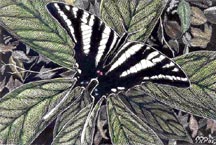 |
|||
|
Volume 12, Issue 31 ~ July 29-August 4, 2004
|
|||
|
|
Zebra Swallowtail and Pawpaw Both the zebra swallowtail and pawpaw are North American relatives of tropical families. In Peterson Field Guides for trees and butterflies, I found that the range maps for each species were practically identical: eastern U.S. exclusive of New England and the northern Great Lakes states. In the Audubon Society Guide to North American Butterflies, author Robert Michael Pyle points out that although it has a broad range, the Zebra Swallowtail is only found near where the pawpaw grows. If you want to attract zebra swallowtails to your garden, you don’t need to go the trouble of planting pawpaw trees. The adult butterflies are attracted to many kinds of nectar sources: flowers such as purple coneflower, butterfly bush, butterfly weed, swamp milkweed, garden phlox and other plants that you can grow from seed or buy at a local nursery. Some wilder plants such as Joe Pye weed, swamp milkweed and dog bane grow in meadows and can sometimes be purchased from specialty nurseries. Check the Maryland Native Plant Society web site for sources of these and other native plants: www.mdflora.org.  Pawpaws grow in dense stands in wet woods and near streams and rivers. They have very large leaves and reach about 40 feet. Other common names are custard apple and the unappealing sounding fetidbush. The wood has no commercial value, but the fruits are eaten by foxes, raccoons and humans. Pawpaws grow in dense stands in wet woods and near streams and rivers. They have very large leaves and reach about 40 feet. Other common names are custard apple and the unappealing sounding fetidbush. The wood has no commercial value, but the fruits are eaten by foxes, raccoons and humans.The fruits have thick, yellowish-orange flesh, which has the consistency of custard plus multiple, large brown seeds shaped like lima beans. They have a delicious, rich and creamy flavor, but their potential as an agricultural product is limited, because they don’t keep well and, by contemporary standards, the fruit itself is unattractive. To harvest pawpaws, first find a stand of trees. Try searching in a stream valley. You might find that only a relatively small percentage of the trees bear fruit. If you keep looking, you may find some ripe fruits on the ground. Young trees have slender trunks. Try gently shaking the trunks to loosen the ripe fruits, which will fall to the ground. As tasty as they are, I find that the flavor is so rich that after eating one or two I’ve had my fill. I’m always tempted to greedily pack a bunch to take home, but in my experience they are never as good as when eaten right there. |
||
|
© COPYRIGHT 2004 by New Bay Enterprises, Inc. All rights reserved. |

